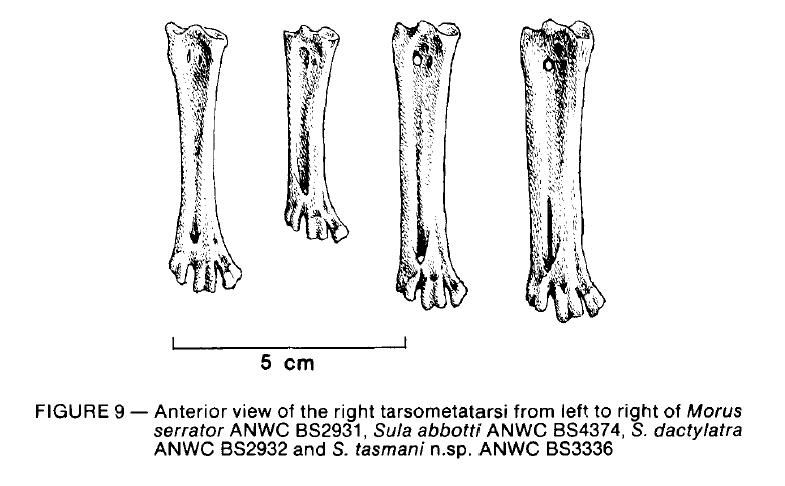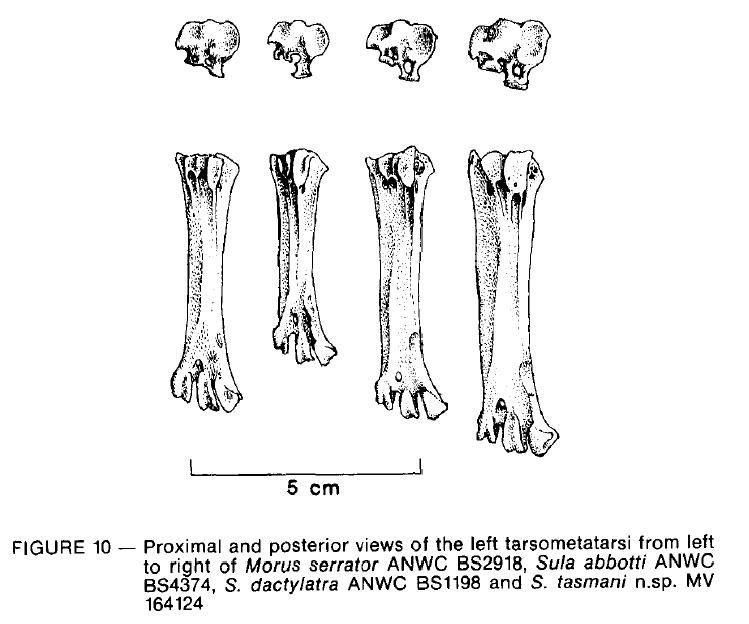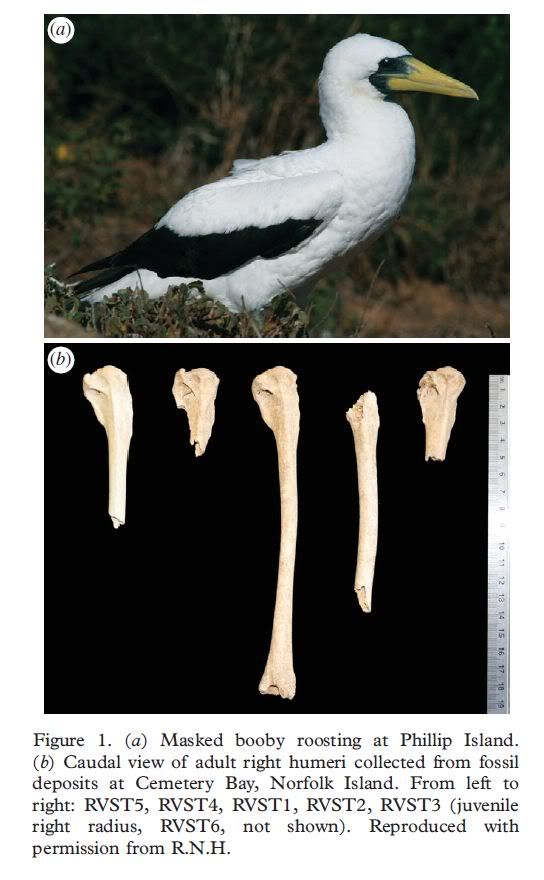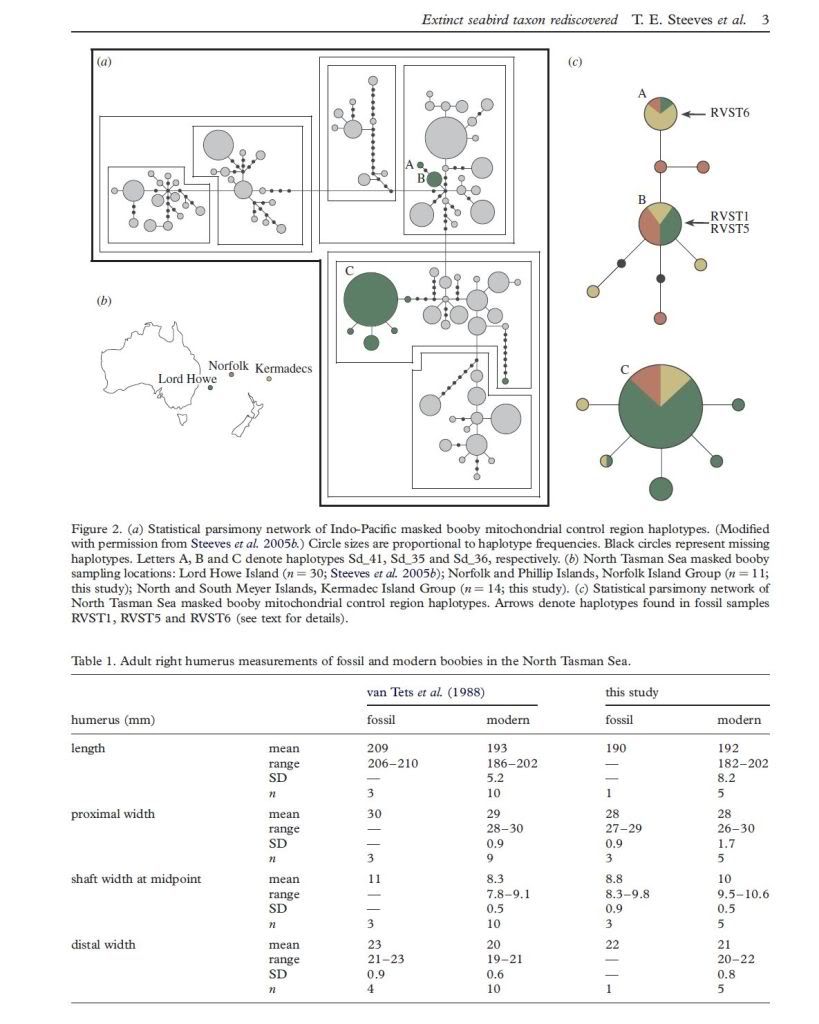Post by another specialist on Aug 4, 2006 20:32:07 GMT

The tarsometatarsus of Sula has a relatively wider shaft than that
of Morus (Figures 9 and 10). The proximal end of the tarsometatarsus
is relatively wider in Sula than in Morus. The intercotylar prominence
is more pronounced in Sula than in Morus. At the proximal end of the
tarsometatarsus, as noted by Harrison (1978 Figure 2), there are differences
between Morus and Sula in the arrangements of the calcaneal ridges and
tendinal canals of the hypotarsus. Morus and Sula have three calcaneal
ridges and three canal positions. Morus has a closed canal between a large
inner ridge and a middle ridge and another closed canal between the middle
ridge and an outer ridge. In Sula abbotti these two canals are open. In
the other extant species of Sula, the outer and middle ridges are fused
without a canal between them, a closed canal is between the middle and
the inner ridges and, as described by Harrison (1978), a single large canal
pierces the inner ridge. The inner ridge is not pierced by a canal in Moms
and Sula abbotti.
The second phalanx of digit I11 is shorter than the first in Moms
and longer than the first in Sula.
The aim of the osteological comparisons reported above was to
determine whether the sulid bones found on Lord Howe and Norfolk
Islands could be identified initially as either Sula or Morus. Besides verifying
published differences, we found more characters that may be used to
distinguish bones of Moms from those of Sula. These characters strengthen
the case for maintaining Morus as a distinct genus.
Osteologically S. abbotti has most of the characters that separate Sula
from Morus. S. abbotti differs from other extant species of Sula in having
a Morus-like ilia1 process on the pelvis and a unique pattern of hypotarsal
canals and ridges. Whether these and other morphological differences merit
a new generic or subgeneric name for S. abbotti will have to await further
study.

SYSTEMATICS
Because the Tasman Booby differs in size and shape from modern and
fossil species in the genus Sula, we propose for it the following new specific
name:
Sula tasmani nsp.
Holotype: ANWC BS3322, part skeleton, including all or parts of the
following elements: maxilla, cranium, mandible, quadrate, cervical and
thoracic vertebrae, sternum, ulna and carpometacarpus. Sand dunes near
Kingston, Norfolk Island.
Paraty es: ANWC BS3318, part skeleton of a juvenile, including all or
parts orthe following elements: maxilla, cranium, mandible, quadrate,
cervical and thoracic vertebrae, ribs, sternum, pelvis, coracoid, scapula,
humerus, radius, ulna, carpometacarpus, wing phalanges, femur,
tibiotarsus, fibula, tarsometatarsus, and pedal phalanges; ANWC BS3326,
part skeleton of a juvenile, including all or parts of: mandible, cervical
vertebrae, ribs, sternum, coracoid, scapula, humerus, radius, ulna, femur,
tibiotarsus, fibula, tarsometatarsus and pedal phalanges. Sand dunes near
Kingston, Norfolk Island.
Referred specimens: Skeletal elements listed in Table 9.
Etymology: Named after the Tasman Sea in which Norfolk and Lord
Howe Islands are situated, and in honour of Abel Janszoon Tasman, who
in I642 sailed across the sea from Tasmania to New Zealand and who
may have seen the bird alive.
Diagnosis. Similar to S. dactylatra but with a body larger and a bill
broader and deeper and more dorso-laterally concave.
DESCRIPTION
Skull
The maxilla of the Tasman Booby 14 specimens - ANWC BS3318
(juvenile), BS3322, BS3323 and BS33331 differs from that of S. abbotti,
which is similar in length, by being narrower at the base, shallower
subterminally, more concave on the sides above the lateral groove, broader
at the tip, and in having the maxillo-jugal junction situated relatively less
posteriorly (Figures 1 and 2). The maxilla differs from that of S. dactylatra,
which is similar in length, by being broader at the base, deeper, and more
concave on the sides above the lateral groove, and broader at the tip (Figures
1 and 2). It differs from those of the other four extant species of Sula
by being much larger and by being broader at the tip.
The cranium of the Tasman Booby 16 specimens - ANWC BS3318
(juvenile), BS3322, BS3325 (juvenile), BS3333, MV 150802 (juvenile) and
1508051 differs from that of S. abbotti, which is similar in length, by being
broader except at the naso-frontal hinge, and by having the temporal fossae
[=crotaphyte fossae of Shufeldt (1888, 1902) and crotaphyte depressions
of Owre (1967)l much larger and meeting at a narrow ridge medially on
top of the cranium. It differs from that of S. dactylatra, which is similar
in length, by having larger temporal fossae. It differs from those of other
extant species of SuEa by being much larger and by having relatively large
temporal fossae.
The mandible of the Tasman Booby [ll specimens - AM F56463,
ANWC BS3318 (juvenile), BS3320, BS3322, BS3324, BS3326 (juvenile),
BS3327, MV 150806, 150808, 163650 and 1641181 differs from that of S.
abbotti, which is similar in length and depth, by having a wider tip, narrower
dentaries, wider surangulars, narrower posterior ends and a large foramen
on the dorsal surface near the internal articular process. It differs from
that of S. dactylatra, which is similar in length, by having a wider tip
and deeper posterior ends and by being slightly longer between the articular
facet and the coronoid process. It differs from those of the other extant
species of Sula by being much larger and by having a broader tip.
Pectoral girdle
The sternum of the Tasman Booby [5 specimens - ANWC BS3318
(juvenile), BS3322, BS3326 (juvenile), MV 150802 and 1508081 differs from that of S. dactylatra, which is similar in size, by having a broader carinal
apex, anterior carinal margin and separation between the dorsal lips of
the coracoidal sulci. It differs from those of the other five extant species
of Sula by being much larger (Figure 3).
The furcula of the Tasman Booby [l specimen - MV 1508081 differs
from that of S. dactylatra, which is similar in size, by having a broader
sternal facet and deeper clavicles. It differs from those of the other extant
species of Sula by being much larger.
The scapula of the Tasman Booby [4 specimens - ANWC BS3318
(juvenile), BS3326 (juvenile), MV 150806 and 1508081 differs from that
of S. dactylatra by being slightly longer with a relatively larger proximal
end. It differs from those of the other extant species of Sula by being
much larger.
The coracoid of the Tasman Booby [6 specimens - ANWC BS3318
(juvenile), BS3321, BS3326 (juvenile), MV 150803, 150806 and 1641851
differs from that of S. dactylatra by being slightly larger with a relatively
broader sterno-coracoidal process, except for ANWC BS3318 (juvenile),
which is similar in size. It differs from those of the other extant species
of Sula by being much larger (Figure 5).
Wing
The humerus of the Tasman Booby [8 specimens - ANWC BS3318
(juvenile), BS3321, BS3326 (juvenile), BS3329, BS3332, BS4298 (juvenile),
BS4299, and MV 1508061 differs from that of S. abbotti by being relatively
thicker with much larger proximal and distal ends and more distally located
attachments for M. latissimus dorsi. It differs from that of S. dactylatra
by being larger, except in juveniles. It differs from those of the other
extant species of Sula by being much larger (Figure 7).
The ulna of the Tasman Booby [8 specimens - ANWC BS3318
(juvenile), BS3322, BS3326 (juvenile), BS3329, BS3332, MV 150806,
150808 and 1641231 differs from those of S. abbotti, S. dactylatra and
S. nebouxii, which are similar in size, by being thicker. It differs from
those of other extant species of Sula by being much longer (Figure 8).
At the distal end of the ulna, the external condyle extends proximally,
relatively less in S. abborti, and relatively more in S. nebouxii and S.
variegata, than in S. sula, S. leucogaster, S. dactylatra and the Tasman
Booby.
The radius of the Tasman Booby [7 specimens - ANWC BS3318
(juvenile), BS3321, BS3326 (juvenile), BS3332, MV 150804, 150806 and
1508081 differs from that of S. abbotti, which is similar in length, by being
thicker and having a larger distal end. It differs from that of S. nebouxii,
which is similar in length, by the shaft being relatively thicker proximally
and relatively thinner distally. It differs from that of S. dactylatra, which
is similar in size, by the bicipital tubercle extending relatively less distally
and having a relatively larger muscle scar in the ulnar depression. It differs
from those of the other extant species of Sula by being much larger.




